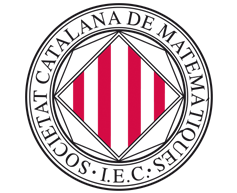Organisers: Eulàlia Nualart (UPF), Matthias Schulte (Heriot-Watt U) and Piotr Zwiernik (UPF)
Friday Oct 23, 15:35 – 17:45, Zoom room Pi i Sunyer
15:35 – 16:15 – Maurizia Rossi (Univ. Milano-Bicocca)
In this talk we deal with the geometry of (random) Laplacian eigenfunctions. In particular, we investigate the fine asymptotic behavior, in the high-energy limit, of the nodal length for random spherical harmonics. It turns out that it is asymptotically equivalent to the sample trispectrum of the underlying field [Marinucci-Rossi-Wigman, 2020], a key result to prove Central Limit Theorems and Moderate Deviation Principles for the nodal length itself [Macci-Rossi-Todino, 2020].
16:20 – 17:00 – Guillaume Poly (University of Rennes)
In this talk we will reviews some recent results around central limit Theorems due to Salem-Zygmund and we will provide some applications to the study of roots of random polynomials.
17:05 – 17:45 – Hélène Halconruy (Institut Mines-Télécom, Paris)
Malliavin calculus, originally developed to provide an infinite-dimensional differential calculus on the Wiener space, was further extended to other processes (Gaussian, Poisson, Rademacher etc.) and has since reached a certain maturity. As part of a work led under the supervision of Laurent Decreusefond, we introduce the definition of Malliavin-Dirichlet structure and develop a discrete version of it, on any countable product of probability spaces. This construction also fits with the pre-existing theories in continuous time and we retrieve the usual Poisson and Brownian Dirichlet structures associated to their respective gradient, as limits of the structures induced by our formalism.
From an application perspective, Malliavin’s toolbox combines advantageously with the famous Stein method to state probabilistic approximation results. Thus, this talk during which will be detailed the path from Stein’s method to the construction of so-called Malliavin-Dirichlet structures and introduced the components of our discrete version, will be motivated by two convergence results: the approximation of the Normal law on the one hand, of the Gamma law on the other hand, by functionals of independent random variables; or, in other words, a discrete analogue of the so-called “Stein-Malliavin criterion” established in Gaussian and Poisson spaces.
Saturday Oct 24, 10:30 – 12:40, Zoom room Pi i Sunyer
10:30 – 11:10 – Carlos Améndola (Technical University of Munich)
The signature of a path is a sequence of tensors whose entries are iterated integrals. We examine them through the lens of algebraic geometry. We introduce varieties of signature tensors for large families of paths, including piecewise linear, polynomial paths, and rough paths. We also explore expected signatures corresponding to Brownian motion and its mixtures. A guiding question is the natural inverse problem of recovering a path from its signature.
11:15 – 11:55 – Guillem Perarnau (Universitat Politècnica Catalunya)
In this talk, we will discuss the minimum positive value of the stationary distribution of a random walk on a directed random graph with given (bounded) degrees. While for undirected graphs the stationary distribution is simply determined by the degrees, the graph geometry plays a major role in the directed case. Understanding typical stationary values is key to determining the mixing time of the walk, as shown by Bordenave, Caputo, and Salez. However, typical results provide no information on the minimum value, which is important for many applications. Recently, Caputo and Quattropani showed that the stationary distribution exhibits logarithmic fluctuations provided that the minimum degree is at least 2. In this talk, we show that dropping the minimum degree condition may yield polynomially smaller stationary values of the form n^-(1+C+o(1)), for a constant C determined by the degree distribution. In particular, C is the combination of two factors: (1) the contribution of atypically thin in-neighborhoods, controlled by subcritical branching processes; and (2) the contribution of atypically “light” trajectories, controlled by large deviation rate functions. As a by-product of our proof, we also determine the hitting and cover time in random digraphs. This is joint work with Xing Shi Cai.
12:00 – 12:40 – Mikolaj Kasprzak (University of Luxembourg)
Functional limit theorems are an important class of results describing convergence in distribution of discrete stochastic processes to diffusion processes. The convergence occurs in a space of functions (the Skorokhod space of cadlag paths) and after a proper rescaling of parameters, such that, in the limit, the chain is forced to make jumps infinitely often and its paths become continuous. Such results prove useful whenever the processes one wishes to model are discrete in nature but it is more convenient to describe them using SDEs. This might be the case, for instance, if the conclusions one wishes to draw are easily obtainable using stochastic analysis or if one does not want changes in the local details to significantly affect the model. Researchers using functional approximations, for instance in population biology (where one may often switch from a discrete model to a continuous one, after a proper rescaling and letting the population size go to infinity), are interested in measuring the error they make when doing so. Stein’s method of exchangeable pairs turns out to be particularly useful in this case and provides powerful upper bounds on distances between the discrete and the limiting continuous processes. In my presentation, I will talk about the theoretical setup for infinite-dimensional Stein’s method, an abstract approximation theorem and concrete models it can be used for. Among the examples I will discuss will be certain classes of U-processes and a graph-valued process.
